18 Different Types of Nail Guns With Their Uses
We discussed 10 types of nail guns based on their uses, 4 types considering their power source and 4 types based on their physical structure.
While decorating your home, inside or outside, the nail gun plays an important role in your woodworking jobs. It might be garden works, door settings, trimming works, furniture settings etc. A quality nailer not only reduces your efforts and time but also ensures quality finishing. In addition, if you properly know how a nail gun works then you could finish your nailing jobs with a professional touch.
It’s difficult to understand which nail gun will be suitable for any specific purpose. Because so many categories and types are available in the market nowadays.
And, for any single purpose all types of nailers are not suitable at all. For this reason, you’ve to be clear about the purpose you want a nail gun for. And, you’ve to be wise while choosing your nailer based on the specifications and configurations. Let’s go through different nail gun types.
10 Types of Nail Guns Based on Their Application
1. Framing Nailer
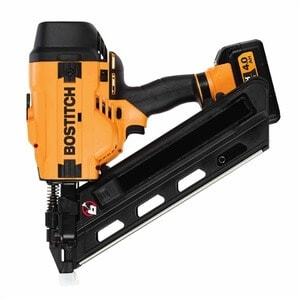
If you are thinking or doing a large project, this type of nailer can be at your help. They have the capability of shooting nails with a diameter of 2.8mm and length up to 3.5 inches. That’s why they are mainly used in heavy nailing projects where one needs maximum holding power.
The framing nailers are of two types: clipped head nailers and round head nailers. Clipped head nailers can hold the maximum number of clips than others. This reduces reloading frequency. But the use of this type is not allowed by most of jurisdictions.
The round head nailers are legal and accepted by all. They have unbelievable power of holding things. That’s why they are in the list of best nailers.
There are two types of framing nailers according to their nail holding capacity. These are stick and coil framing nailers. The coil nailers can hold a lot more nails than stick nailgun.
Application:
- Heavy construction
- Fencing
- Framing House
- Building decks
- Wooden siding
2. Brad Nailer
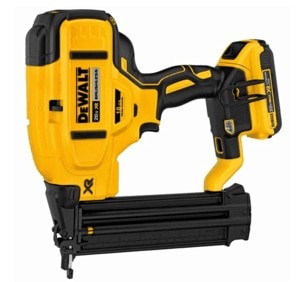
Brad nailer is a multipurpose tool for DIYer work. They have 18 to 23-gauge nail which is 0.5 to 2 inch in length. They mostly use in small woodworking projects for the household.
The magazine is not angled here. But it throws gauge nails. They are very small but they provide great support. This type of nailers also offers switchable contact, deep drive adjustment, cordless arrangement and quality air hookups.
Application:
- Baseboard installation
- Cabinet construction
- Paneling walls
- Furniture repair
- Interior moulding
3. Finish Nailer
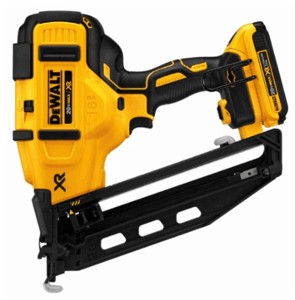
Finish nailers are one of those nailers which are used for various tasks. They are consists of smaller nails than framing nailers.
They typically use 15 and 16 gauge nails like brad nailers. The interesting thing about the finish nailer is they have tremendous holding power with no sign of big holes.
Yes! You got it right, this is because of those large nails.
Nowadays, finish nailers with lithium-ion has great demand. Many of them are cordless also.
They are commonly divided into two types Angled and Straight Finish Nailer based on their structure and use.
They are the best option for beginner or people who tend to do woodworking a very little period of time. That’s why small household works are done by using this tool.
Application:
- Installing Cabinets
- Assembling Furniture
- Trim
- Molding
- Cabinetry
4. Roofing Nailers
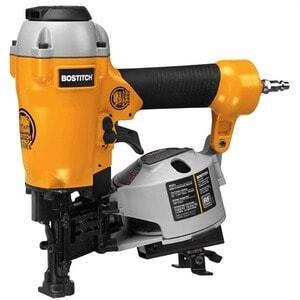
These nailers are used for nailing particular roofing nails such as asphalt shingles, underlayments of houses. They are very lightweight and easy to handle. They own coil magazine to hold more nails.
These nailers have a configurable system to decide the depth of shoot the nail. This depth drive adjustment is needed because the shingles are soft. Too much force can damage the shingle. This is another reason for which roofing nailers have the flat large head.
Application:
- Roofing
- Siding
- Installing Underlayment
- Roofing Shingles
5. Flooring Nailer
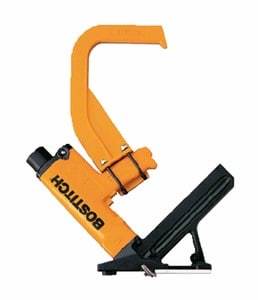
Flooring nailers are designed in such a way that one can easily install anything on the floor by using it. It also gives the opportunity to nail without keeping knee down.
You can stand upright and pull the trigger. The nailer will do the rest. Floor nailers emit specialized cleat nails for flooring. These nails differ in their shape like T shaped, L shaped etc.
Both of them provide smooth and faster outputs which are the first demand of a customer.
Application:
- Installing wooden Materials on a floor
6. Siding Nailer
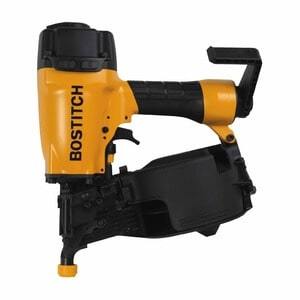
You can guess the application of this type of nailer by the name. Siding nailers are specially made for attaching siding. It is must tool if you do siding projects very frequently.
These nailers have 1.4 to 2.5-inch nails in length. Sometimes these nails are made of aluminium which is used for aluminium siding.
But they work best when they are attached with wooden surfaces.
Though siding can be done by using framing nailers, I recommend siding nailers for best output.
Application:
- Combining thin and siding material with wooden exteriors.
7. Pin Nailer
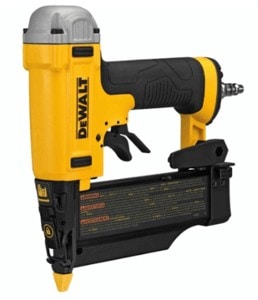
Woodworkers especially crafts makers love this type of nailers. Because pin nailers of reputed brands have made their task very easy and smooth. They are very small in size and power is also very low. But they come in handy in particular situations.
The nailers come with a head but use 22-23 gauge nails. These nails are appropriate for making small houses for pets, crates, panels etc.
If you have any delicate trimming or moulding work, 23 gauge pin nailer is the best solution for you.
Application:
- Combining subtle trim pieces
- Holding pieces
- Crafting
8. Palm Nailer
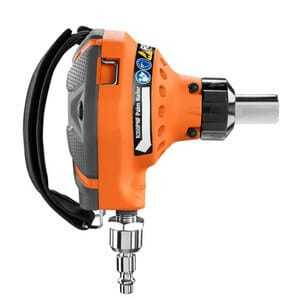
The name itself is expressing its definition. You can hold this type of nailer with ease and do whatever you want. They are sized like a small nail gun that uses the air compressor to do nailing with lightning speed.
The nails are naturally 1.5 to 3.5-inch long. These nailers have the ability to reach those tiny little positions where others can enter.
They are specially used on such occasions where normal nailers or hammer can’t serve the purpose.
That’s why if you want a nailer with a smaller size, easy hold and best output from your project, I suggest you should go for a quality palm nailer but of course from reputed brands.
Application:
- Fencing
- Framing
- Remodeling
- Crafting
9. Hammer Tacker
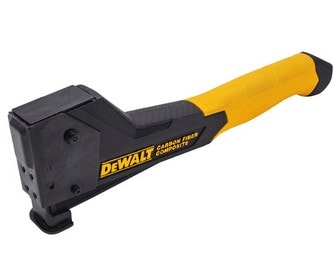
A hammer tacker is a very user friendly and practically workable tool as it contains a grip to hold the tacker tight and push the stapler on the desired surface. Mostly it is used in the roof side works and on carpets layers. It generally weighs 1.8 to 2.2 pounds and a length of about 8” to 14”.
It differs from the staple gun based on the orientation of the layers. Normally a hammer tacker works after a strong vertical stroke. Such a stroke pushes its head towards the surface where staplers need to be placed. Staplers get placed on the desired position loaded in the head before.
Application:
Hammers tackers are best for –
- installing insulation
- roofing,
- house wrap
- flooring.
10. Staple Gun or Trigger Gun
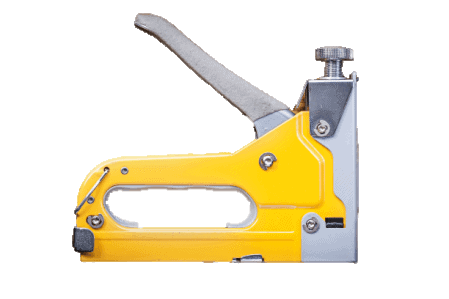
Alike hammer tacker it works in vertical surfaces better. It’s not as long as a hammer tacker but quite handy and works over all kinds of possible surfaces. It pushes staplers on the surfaces and makes a rigid placement.
Like a hammer tacker, it has a tool to pull wrongly placed staplers off the surface. Hammer tracker is applicable for horizontal surfaces whether staple guns are suitable for vertical surfaces.
Application:
Staple gun has its use on
- Carpeting
- Picture framing
- Upholstery
- fastening fabric
- ceiling tiles
- weather stripping
- carpets
- foam and padding
- wire
- screening
4 Nail Gun Types Based on Power Source
Based on how a nailer operates that means its power source nail gun can be classified into 4 types. They are
1. Pneumatic or Air Operated Nail Gun
A Pneumatic nail gun is unquestionably one of the most popular sorts of nail guns. It gets power from the compressed air supply, that’s why it is also called air operated nail gun. In this nail gun, a typically hammering force comes from compressed air, which is generated from a gas-powered air compressor.
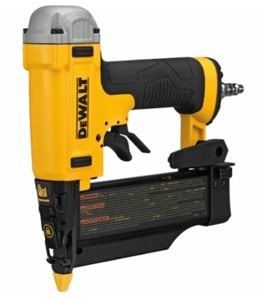
The air compressor in Pneumatic works like a water pump. It contains one or multiple piston cylinders. Usually, the air-operated nail gun works in two steps. In the first step, the cylinders take air from the atmosphere on the upstroke. In the second step, inhaled air push it out towards the air reservoir eventually to the hammer located in the bottom part of the gun.
2. Corded Electric Nailer
A corded electric nail gun is the first generation, electric nailer. Due to the update of the technology, those guns are losing their appeals. Once these nailed used to be the most anticipated. The only shortcoming of this nail gun is the length of the cord, which made this nonportable.
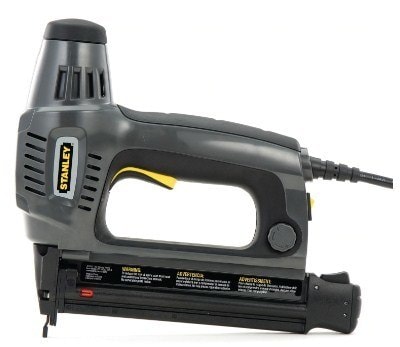
On the other hand, the good thing is that, like the battery-operated one, it has no time limitation. As long as it is connected to the power source, it can be used all day, and you don’t need to take the hassle for recharging the battery. These come handy for the small scale of the task. These guns are used for nailing the short nails such as brads and staples.
3. Battery Operated or Cordless Electric Nail Gun
These nailers are run off lithium-ion-battery, which ensure long enough charge for the whole day. Additionally, carrying extra batteries is another source of power.

The best thing about cordless nailers is the portability, though they are not able to do a massive task like the Pneumatic. Battery operated nail guns are easy to use, which can be used for any light nailing as it does not have an air compressor.
4. Combustion or Gas Operated Nail Gun
This is somewhat like pneumatic nailers but the power source it uses is gas. The gas-powered nail gun was first introduced in 1986 by The Paslode Company, which is a division of Illinois Tool Works. In that time, the framing nailer was referred to as Impulse. Gas-powered nailers are versatile than an air nail gun that also efficient, convenient, and comfortable. Being cordless is the best thing about this tool.
Butane is a flammable fuel that is stored in a disposable internal cell and a battery, which is used in Gas nailers. Besides, liquid petroleum can also be used to be used as fuel. As soon as you trigger the nail gun, fuel is released. After that, battery sparks and burns the fuel. That spark converts to explosive energy, which shoots the nail to the surface of the material. After the nail released from the gun, another nail is loaded automatically. Usually, a gas nail gun does not have any cord and referred to as a cordless gun.
.
4 Types of Nailers Based on Physical Structure
Depending on how a nail gun looks, It can be divided into 4 categories. These are
1. Coil Nailer
A coil nailer is mostly used on the roof work, which is also referred to as a roofing nailer. Besides, it is also used in exterior drywall. Unique nails are needed to work with a coil nailer, usually the nails that come on a coil.

The coil gun is small, which makes it easy to use and portable. This high-performance nailer does a perfect job rather than a manual hammer. The holding capacity of nails is higher than any other tool. The magazine of a coil gun can hold up to 150 coil nails
2. Stick Nail Gun
If you want to use a variety of nails in a single nailer, a stick nail gun will be a perfect choice. Using a stick nailer is a bit tricky. Angle and collation style needs to check while nailing through stick gun.
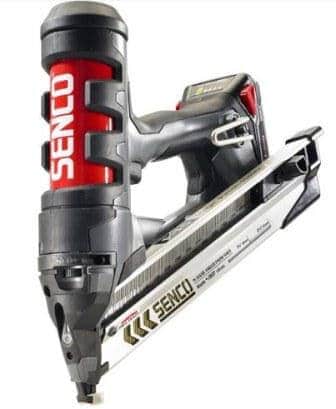
Nails are stored in a lengthy magazine in a stick nailer, which can hold 25-40 nails. All the nails are organized together at a specific angle. Heads of the nails are nested above other the head of other nails located in front of the nested ones. Three styles of nails can be nailed through the stick gun Paper collated nail, Plastic collated nail and Wire-weld collated nail.
3. Angled Nailer
Angled finish nailer comes convenient in working in tight spaces. It is vastly used for cabinet making and work around corners or doors.

Nails for an angled nailer usually hard to find as they are expensive. Finish nailers vary from model to model, which comes with a variety of angles. The angle of the nails stayed 21-34 degrees. These nails are a little longer than the regular nails.
So, you have to get the right kind of nails for your specific nailer as the magazine is not unified.
4. Straight Nail Gun
Straight nailers are great for basic framing and straightforward construction. This nailer is mostly used in visible plain surface. They use little thin nails so that the nail head remain hidden.

Nails are widely available and less expensive. So, it is best for the woodworkers who are looking for a cost-effective nail gun to work in an open space.
The downside of this nail gun is bulky, so it cannot be used in tight space. They have large magazines than the angled nailer as the magazine is set at a 90-degree angle.
Final Words
Finally, you’re now having an idea by assessing different types of nail guns which one would fit your requirement. Now, you need to go through specifications one by one, have a thorough idea and buy your nail gun. Give your nailing project a better look.
